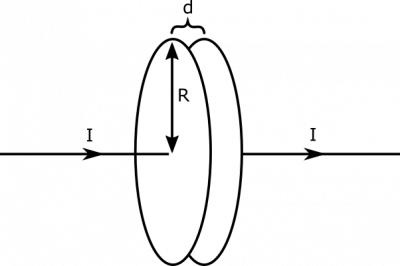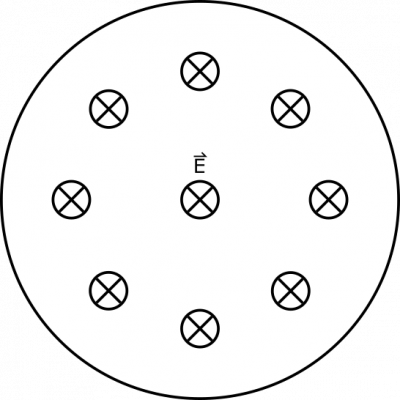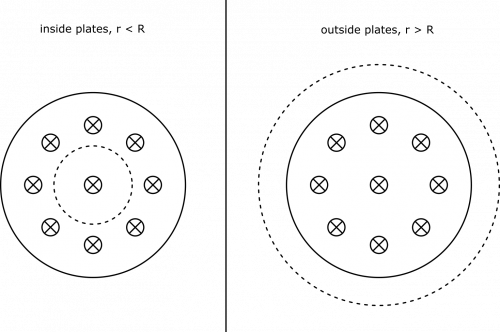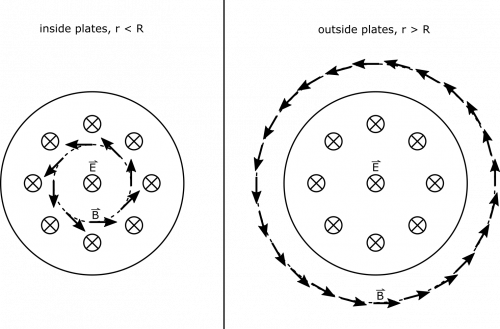This is an old revision of the document!
Magnetic Field from a Charging Capacitor
Suppose you have a parallel plate capacitor that is charging with a current $I=3 \text{ A}$. The plates are circular, with radius $R=10 \text{ m}$ and a distance $d=1 \text{ cm}$. What is the magnetic field in the plane parallel to but in between the plates?
Facts
- The capacitor is a parallel plate capacitor with circular plates.
- $R=10 \text{ m}$
- $d=1 \text{ cm}$
- The capacitor is charging with a current $I=3 \text{ A}$.
Lacking
- A description of the magnetic field.
Approximations & Assumptions
- We are only concerned about a snapshot in time, so the current is $I$, even though this may change at a later time as the capacitor charges.
- The electric field between the plates is the same as the electric field between infinite plates.
- The electric field outside the plates is zero.
Representations
- We represent the electric field in a parallel plate capacitor as $$\vec{E} = \frac{Q/A}{\epsilon_0} \hat{x}$$ where $Q$ is the charge on a plate, $A$ is the area of the plate, and $\hat{x}$ is directed from one plate to the other.
- We can represent the magnetic field from a changing electric field as
$$\int \vec{B}\bullet \text{d}\vec{l} = \mu_0 I_{enc} + \mu_0\epsilon_0\frac{\text{d}\Phi_E}{\text{d}t}$$
- We represent the situation with the following visual:
Solution
We wish to find the magnetic field in the plane we've shown in the representations. Due to the circular symmetry of the problem, we choose a circular loop in which to situate our integral $\int \vec{B}\bullet\text{d}\vec{l}$. We also choose for the loop to be the perimeter of a flat surface, so that the entire thing lies in the plane of interest, and there is no enclosed current (so $I_{enc} = 0$). We show the drawn loop below, split into two cases on the radius of the loop.
Below, we also draw the direction of the magnetic field along the loops. We know the magnetic field is directed along our circular loop – if it pointed in or out a little bit, we may be able to conceive of the closed surface with magnetic flux through it, which would imply the existence of a magnetic monopole. This cannot be the case! We also know that the field is directed counterclockwise, due to the increasing electric field into the page. This comes from an extension of Lenz's Law, upon which discussion is not needed for this course.
We are pretty well set up to simplify our calculation of the integral in the representations, since the B-field is parallel to the loop's perimeter. Below, we show the integral calculation, where the magnetic field at a radius $r$ is displayed as $B(r)$.
$$\int \vec{B} \bullet \text{d}\vec{l} = \int B(r) \text{d}l = B(r) \int \text{d}l = 2\pi r B(r)$$
Next, we need to find the changing electric flux in our loop. Since our loop was described with a flat surface, and the electric field is directed parallel to the area-vector of the loop, we can write electric flux as $\Phi_E = \vec{E} \bullet \vec{A} = EA$. This formula will need to be split up for parts of the surface inside the plates versus outside, since the electric field is different.
$$\Phi_\text{E, in} = EA = \frac{Q/A_{\text{loop}}}{\epsilon_0} = \frac{Q}{\epsilon_0\pi r^2}$$ $$\Phi_\text{E, out} = EA = E_\text{in}A_\text{in} + E_\text{out}A_\text{out} = \frac{Q/A_{\text{plate}}}{\epsilon_0} + 0 = \frac{Q}{\epsilon_0\pi R^2}$$
Now, if we wish the find the change in flux, we will take a time derivative. Notice that all the terms in the flux expressions above are constant, except for $Q$, which is changing with time as dictated by $I$.
$$\frac{\text{d}\Phi_E}{\text{d}t} = \frac{\frac{\text{d}Q}{\text{d}t}}{\epsilon_0\pi r^2} = \frac{I}{\epsilon_0\pi r^2} \text{, inside, } r<R$$ $$\frac{\text{d}\Phi_E}{\text{d}t} = \frac{\frac{\text{d}Q}{\text{d}t}}{\epsilon_0\pi R^2} = \frac{I}{\epsilon_0\pi R^2} \text{, outside, } r>R$$
We can now connect the pieces together. We can write:
$$$$



